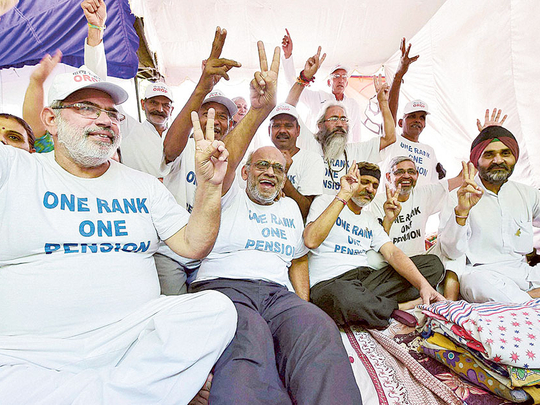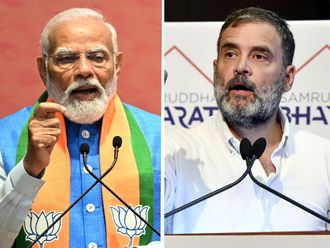
NEW DELHI: Three million Indian army veterans won a decades-long battle Saturday to change the way their pensions are calculated, as the government bent to protesters’ demands and announced it would overhaul the controversial scheme.
India’s armed forces personnel, who typically retire earlier than other public sector workers, have mounted fierce opposition in recent months to the current pension scheme, which is based on their salary when they retire.
They argue this leaves them vulnerable to inflation eroding their livelihoods and say it is unfair that a soldier who retired recently should receive a larger pension than one who left service earlier.
Under the newly agreed ‘One Rank, One Pension’ (OROP) deal, ex-servicemen will now receive a pension based on 2013 salaries, to be refixed every five years — irrespective of when they retired.
“Despite the financial burden, the government of India has taken the decision to implement OROP,” Defence Minister Manohar Parrikar said at a press conference in New Delhi on Saturday.
The scheme will cost Rs80-100 billion (Dh4.41-5.51 billion), he said. Military pensioners will receive arrears dating back to July 2014.
“Now that the issue of OROP is hopefully behind us, I appeal to the veterans to continue to contribute to the vital task of nation building and development,” Parrikar said.
Introducing OROP was one of Prime Minister Narendra Modi’s key pledges as he led the Bharatiya Janata Party’s successful campaign for last year’s general election.
Veterans have fought for the OROP scheme for four decades, but protests have intensified in recent months, with ongoing rallies in New Delhi and several protesters going on hunger strike.
Observers say the move could open the door for workers in other state-run industries such as railways to demand similar reforms.
India has one of the world’s largest armies, with around 1.32 million active personnel and 2.14 million reservists.
Retirement age varies with rank, with the maximum age of service ranging from 56 to 62 years, according to the Indian Army website.
Mulling committee
Meanwhile, the government is considering appointing a committee under a judge to go into the issue of equalisation of pension, a leader of the ex-servicemen group fighting for One Rank One Pension said after a meeting with Defence Minister Manohar Parrikar.
Maj Gen Satbir Singh (retd), Chairman of Indian Ex-Servicemen said the government while accepting the concept of the OROP, was still insisting on pension revision every five years and that is why it was thinking of constituting a committee.
Singh said after the meeting that in that case a representative of the veterans and one from the services should also be in the committee. He said the committee should not take more than one month.
“Government has accepted the OROP concept broadly,” the Chairman of Indian Ex-Servicemen movement told reporters after the meeting.
He said it was conveyed to the Defence Minister that no junior should get more pension than seniors and that there is nothing like Voluntary Retirement Service in defence forces.
Sounding a conciliatory note, Singh said the government has accepted 60 per cent of the demands of the ex-servicemen.
He, however, said the “bone of contention” — revision of pension — still remains.
After the meeting, Parrikar met BJP President Amit Shah. Later a BJP leader said all demands of the ex-servicemen have been accepted except the pension revision demand.
The ex-servicemen have been demanding that the pension revision should take place at least in every two years while government has proposed a five-year revision.
—AFP, PTI












